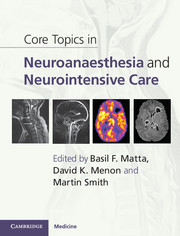Crossref Citations
This Book has been
cited by the following publications. This list is generated based on data provided by Crossref.
Pourfathi, Mehrdad
Clapp, Justin
Kadlecek, Stephen J.
Keenan, Caroline D.
Ghosh, Rajat K.
Kuzma, Nicholas N.
and
Rizi, Rahim R.
2016.
Low‐temperature dynamic nuclear polarization of gases in Frozen mixtures.
Magnetic Resonance in Medicine,
Vol. 76,
Issue. 3,
p.
1007.
Löser, Benjamin
Recio Ariza, Olga
März, Alexander
Löser, Anastassia
Grensemann, Jörn
Petzoldt, Martin
Reuter, Daniel A.
Weber, Frank
Glass, Änne
Haas, Sebastian A.
and
Li, Yan
2019.
Retrospective analysis of central venous catheters in elective intracranial surgery - Is there any benefit?.
PLOS ONE,
Vol. 14,
Issue. 12,
p.
e0226641.
Klyukin, M. I.
Kulikov, A. S.
Belisov, I. M.
and
Lubnin, A. Yu.
2019.
Comparison of clinical efficacy of fosaprepitant and droperidol for prevention of postoperative nausea and vomiting after subtentorial craniotomy.
Anesteziologiya i Reanimatologiya,
p.
56.
Klyukin, M. I.
Kulikov, A. S.
and
Lubnin, A. Yu.
2019.
Postoperative nausea and vomiting in neurosurgery: the approaches are varied but the problem remains unsolved.
Voprosy neirokhirurgii imeni N.N. Burdenko,
Vol. 83,
Issue. 2,
p.
93.
Kaipainen, Aku L
Martoma, Erik
Puustinen, Tero
Tervonen, Joona
Jyrkkänen, Henna-Kaisa
Paterno, Jussi J
Kotkansalo, Anna
Rantala, Susanna
Vanhanen, Ulla
Leinonen, Ville
Lehto, Soili M
Iso-Mustajärvi, Matti
Elomaa, Antti-Pekka
Qvarlander, Sara
and
Huuskonen, Terhi J
2021.
Cerebrospinal fluid dynamics in idiopathic intracranial hypertension: a literature review and validation of contemporary findings.
Acta Neurochirurgica,
Vol. 163,
Issue. 12,
p.
3353.
MAZLUM, Zeynep
BASER, Baris
and
İMAMOĞLU, Melih
2023.
Ultrasonographic Evaluation of Intracranial Pressure during Rapid Maxillary Expansion.
Cumhuriyet Dental Journal,
Vol. 26,
Issue. 3,
p.
303.
Barnes, Nicola
Boella, Sophie
May, Lindy
Moven, Ainsley
and
O'Connor, Jody
2023.
The Great Ormond Street Hospital Manual of Children and Young People's Nursing Practices.
p.
453.





